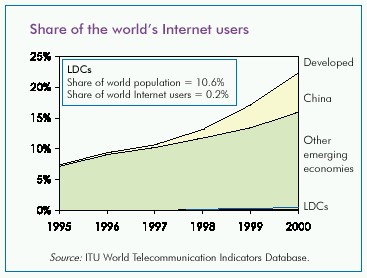Improving IP connectivity in the least developed countries:
Breaking the vicious circle of poverty and high prices
ITU is currently looking at ways to improve Internet penetration in the least developed countries
Despite the fact that some 264 countries now have Internet access, the Internet is still a rare privilege in the least developed countries, where just two in each thousand members of the population has Internet access — far less than the average of one in twenty for other developing countries and, as might be expected, way below the one in four citizens who have Internet access in some major economies.
The reasons for this disparity lie not only in the extreme poverty of LDCs, but also in the scarcity of economic,
institutional and human resources, often compounded by geophysical factors. The Internet, with its requirement for high-quality, high-speed connections, places heavy demands on infrastructure. In most of these countries however — especially in landlocked territories or remote islands — national and international Internet connectivity is in short supply: optical fibres may not be available, satellite links are limited and expensive, and internal telecommunication infrastructures are typically concentrated in a few main cities and present severe shortcomings in rural areas. These obstacles, together with lack of clear telecommunication policies and regulations and an internal market that is often closed to competition, result in a lack of investment and highly-priced services, all of which impede Internet penetration.
 ITU is currently considering a project to enhance Internet connectivity in the LDCs, as a practical step towards bridging the digital divide. One of the main objectives of the project is to increase the bandwidth capacity of Internet service providers (ISP) in the LDCs through the use of satellite technology (e.g. very small aperture terminals, or VSAT). This is to be achieved by “pooling” demand for Internet bandwidth among the countries concerned, and helping to finance the purchase of satellite capacity by ISPs to enable them to provide lower-cost access to end-users, schools, hospitals and other entities. The ISPs would undertake to respect certain conditions and requirements (e.g. number of communities covered, reduced price of services for non-commercial end-users and cybercafés, etc.). In the longer term, connectivity should be self-financing after the project has terminated. ITU is currently considering a project to enhance Internet connectivity in the LDCs, as a practical step towards bridging the digital divide. One of the main objectives of the project is to increase the bandwidth capacity of Internet service providers (ISP) in the LDCs through the use of satellite technology (e.g. very small aperture terminals, or VSAT). This is to be achieved by “pooling” demand for Internet bandwidth among the countries concerned, and helping to finance the purchase of satellite capacity by ISPs to enable them to provide lower-cost access to end-users, schools, hospitals and other entities. The ISPs would undertake to respect certain conditions and requirements (e.g. number of communities covered, reduced price of services for non-commercial end-users and cybercafés, etc.). In the longer term, connectivity should be self-financing after the project has terminated.
Establishing a reliable infrastructure that can enable access to international Internet capacity at low cost could be
the first step towards breaking the “vicious circle”, and creating a “virtuous [Internet] circle” in LDCs. For further information, visit the website at:
www.itu.int/ipdc.
For further information on Policy and Strategy Trends, please contact: ITU Strategy and Policy Unit, International Telecommunication Union, Place des Nations, CH-1211 Geneva 20 (Switzerland). Fax: +41 22 730 6453. E-mail: spumail@itu.int. Website: www.itu.int/osg/spu/
|
|